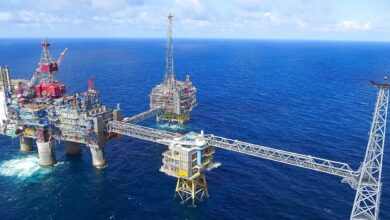Drilling optimization enhances development of harsh-environment East Shetland fields
By Charles Taylor and Derek Liversidge, EnQuest PLC; Ian Tribe and Katy Heidenreich, Schlumberger
New operator in the North Sea EnQuest PLC, which acquired Petrofac Energy Developments Ltd, faced a daunting first drilling project in the northern-most reaches of the East Shetland basin. The goal was to develop the West Don and Don Southwest fields, which were discovered in 1975 but had lain fallow for a third of a century awaiting a commercially viable development plan. The location brought with it harsh environmental challenges.

Due to weather conditions in the area, for example, floating rigs can experience serious heave issues. Logistics are also problematic due to weather and the fields’ distance from Aberdeen. A typical well construction sequence on a third-generation semi requires 70 to 80 days to execute.
EnQuest’s drilling program included two producers and a single water-injector well on West Don and two of each type on Don Southwest (Figure 1). Well construction was mainly handled by Transocean’s John Shaw, a Pacesetter-class semisubmersible considered relatively small by North Sea standards.
In order to optimize well construction, the company decided to first tackle the challenge of cuttings removal and transport. With traditional large-diameter surface holes of the past, penetration rates in the surface-hole section were limited to 200 ft/hr. The company decided to decrease the borehole size in order to reduce cuttings volume.
The plan called for drilling with an 8 ½-in. bit to the top of the pay zone, then change to a 6-in. bit for the reservoir. By drilling a smaller well, not only would the volume of cuttings be reduced, but the costs of tubular goods and drilling fluids would be reduced as well.
The company also decided to monitor downhole drilling parameters in real time in order to improve rate of penetration (ROP), by managing potentially damaging drillstring vibrations. The goal was to achieve shoe-to-shoe drilling at optimum penetration rates.

In the 2009 phase 1 campaign, seven wells were drilled that comprised a total of 105,575 ft (32,187 m). Six of the seven wells were drilled shoe to shoe. In one well, a 3,000-ft (915-m) 6-in. horizontal reservoir section was drilled in a single run. In all, over the span of less than a year, 35 well sections were constructed in 51 bit runs (Figure 2).
Schlumberger provided the PowerDrive Xceed and PowerDrive X5 rotary steerable and the VISION logging-while-drilling (LWD) systems for EnQuest’s project. Hole cleaning and four-axis tool vibration were monitored in real time and directional adjustments were made to the BHA assembly, resulting in fewer bit trips, fewer tool failures and successful shoe-to-shoe drilling. This efficiency allowed the operator to drill two additional, unplanned appraisal sidetracks in a limited time period.
Schlumberger and EnQuest also held performance reviews on a regular basis to highlight the success of better drilling practices and to determine direction for the next step of the program. These reviews have now become drilling optimization workshops that will be held prior to and throughout the 2010 phase 2 campaign.
First oil was achieved at West Don in April 2009 and at Don Southwest in June 2009, less than a year after the field development program was approved. The Northern Producer FPSO has been contracted to receive the oil. After initial processing, the oil was first shipped to shore by shuttle tanker. Since March 2010, it has been exported using a pipeline oil export service via the nearby Thistle platform.
EnQuest PLC is an independent oil and gas production and development company whose activities focus on the UK Continental Shelf .
PowerDrive Xceed, PowerDrive X5 and VISION are marks of Schlumberger.




